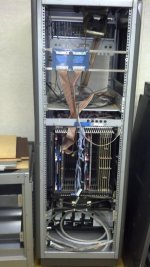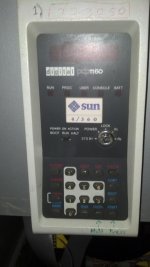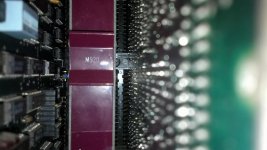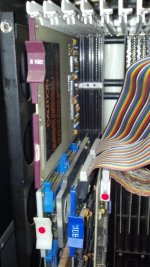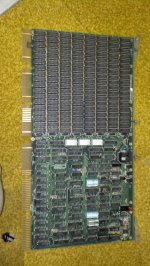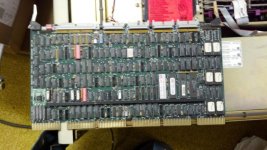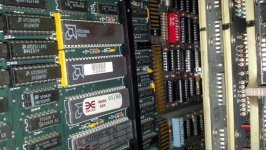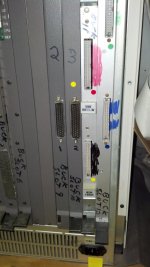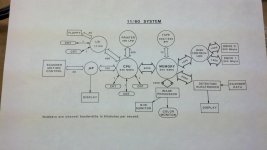lowen
Veteran Member
I have received two rather nice older DEC systems here, and was wanting to see some opinions on which would be the 'cooler' and which would be the more 'doable' restoration projects with an eye to a working museum environment.
System number one is a PDP 11/60 in a non-original but very cool 42U rack. Number two is an 11/84 in the standard DEC rackmount chassis, but not in a rack.
Both of these systems have Emulex SU3110401 SMD interface cards (the only reason I know they're SMD is because the three drives that came with the two systems are SMD: Control Data SABRE 9720 368MB 8-inch non-removable media drives). Both systems have a pair of MDB DR11-B-compatible DMA cards cabled to a Sun 4/360 VME system. The 11/60 programmer's console even has the Sun 4/360 badge on it.....
I know that there are folks here with 11/84s running, but does anyone here have a running 11/60? (A search of the forum for 11/60 turns up empty.)
If so, how difficult was it to get running? I do have a spare set of cards for the 11/60 CPU (M7872, M7873, M7874, M7875, M7876, and M7877) as well as a spare RAM board for the 11/60 (Standard Memories MM-147; has 8 rows of 18 4116 DRAM's on it (128KW/256KB)). The 11/60 has what appears to be three DL11-W compatible cards; one is an actual M7856 but the other is a clone.
The 11/84 (says it's an 11/84-PC on the chassis) has an Emulex SMD controller, two MDB DR-11B DMA boards, two (clone) DL11-W SLU's, the M8191 UBA, two M7458-AC RAM cards (MSV-11-RA), the M8190 CPU (I didn't check the rev on this one, but will), and the M7677 MDM.
I have the key for the 11/60 but not for the 11/84; the 11/60 uses the XX2247 key, but not sure what the 11/84 would use.
So I'm looking for the collective experience in bringing these systems up; things like trouble spots to look for, etc, along with an idea of which system would be the more appropriate system to have up and running both as a living museum piece as well as a data-recovery piece. My gut feel is that the 11/84 may be the more 'useful' one to have running, with the 11/60 in display condition, but I'm certainly willing to be corrected on that.
The two units were used to control a historic (and gorgeous, in a technical sort of way) astronomical plate scanner, and so there is a rack full of custom interface electronics that interfaces to the scanner hardware as well. The bulk of the software is written in PolyFORTH, I think.
I can provide photos a bit later. Any advice is appreciated!
System number one is a PDP 11/60 in a non-original but very cool 42U rack. Number two is an 11/84 in the standard DEC rackmount chassis, but not in a rack.
Both of these systems have Emulex SU3110401 SMD interface cards (the only reason I know they're SMD is because the three drives that came with the two systems are SMD: Control Data SABRE 9720 368MB 8-inch non-removable media drives). Both systems have a pair of MDB DR11-B-compatible DMA cards cabled to a Sun 4/360 VME system. The 11/60 programmer's console even has the Sun 4/360 badge on it.....
I know that there are folks here with 11/84s running, but does anyone here have a running 11/60? (A search of the forum for 11/60 turns up empty.)
If so, how difficult was it to get running? I do have a spare set of cards for the 11/60 CPU (M7872, M7873, M7874, M7875, M7876, and M7877) as well as a spare RAM board for the 11/60 (Standard Memories MM-147; has 8 rows of 18 4116 DRAM's on it (128KW/256KB)). The 11/60 has what appears to be three DL11-W compatible cards; one is an actual M7856 but the other is a clone.
The 11/84 (says it's an 11/84-PC on the chassis) has an Emulex SMD controller, two MDB DR-11B DMA boards, two (clone) DL11-W SLU's, the M8191 UBA, two M7458-AC RAM cards (MSV-11-RA), the M8190 CPU (I didn't check the rev on this one, but will), and the M7677 MDM.
I have the key for the 11/60 but not for the 11/84; the 11/60 uses the XX2247 key, but not sure what the 11/84 would use.
So I'm looking for the collective experience in bringing these systems up; things like trouble spots to look for, etc, along with an idea of which system would be the more appropriate system to have up and running both as a living museum piece as well as a data-recovery piece. My gut feel is that the 11/84 may be the more 'useful' one to have running, with the 11/60 in display condition, but I'm certainly willing to be corrected on that.
The two units were used to control a historic (and gorgeous, in a technical sort of way) astronomical plate scanner, and so there is a rack full of custom interface electronics that interfaces to the scanner hardware as well. The bulk of the software is written in PolyFORTH, I think.
I can provide photos a bit later. Any advice is appreciated!

